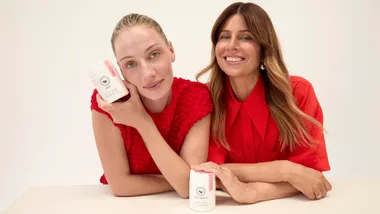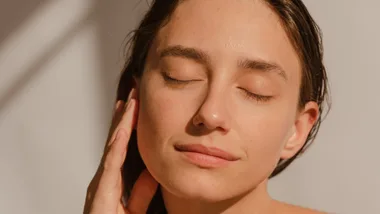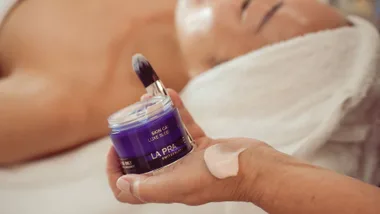There’s a reason Australia is known as the “sunburnt country”.
With the highest rate of skin cancer in the world (accounting for over 80 per cent of all new cancer cases diagnosed in Australia each year*), the sun safety message has been drilled into many of us since childhood.
While applying a high SPF sunscreen every single day should be a non-negotiable part of our skincare routine, there are some moments where it might slip our minds… especially in the cooler months when the sun doesn’t always seem to shine.
Here, dermatologist Dr Cara McDonald explains why SPF coverage—and sun protection in general—is so important for the health of our skin, no matter the time of year.
Sun Exposure Can Accelerate The Signs Of Ageing
While the short-term effects of too much exposure to the sun are obvious—hello, painful and red sunburn—UV can also wreak havoc on our skin over time.

“It’s estimated that up to 90 per cent of premature ageing of the skin is a direct result of UV damage from sun exposure,” says Dr. McDonald.
That means all the anti-ageing ingredients, serums and procedures are for nothing without daily protection from the sun.
“Our most effective anti-ageing habit is strict sun protection, including sun avoidance, sunscreen, shade and protective clothing.”
So how exactly does ultraviolet radiation—and more specifically, both UVB and UVB rays—affect our skin?
While they both contribute to the development of skin cancer and premature ageing, “UVB penetrates the more superficial layer of the skin, known as the epidermis,” says Dr McDonald.
“UVB causes direct damage to the skin cells, and may result in the majority of DNA damage. Down the track, those cells may remain abnormal and may become cancerous.”
UVA rays, however, penetrate deeper into our skin, causing damage to the collagen and elastin fibres that give our skin thickness, strength and elasticity (aka that plump, firm and radiant look).
“UVA is largely responsible for thinning of the skin, wrinkling and other signs of premature ageing via direct damage, and by activating the enzymes that break down collagen,” says Dr McDonald.
UVA rays, she says, also decrease the immune function within the skin over time, increasing “free radicals which results in further cellular and collagen damage”.
Do We Need To Wear SPF All Year Round?
While UVB rays are at higher levels during the summer months, UVA is more constant all year round—even on cold, overcast days.
“UVA can penetrate through clouds and glass and is less obvious to us, as we don’t feel the heat and burning on the skin which we do from UVB,” says Dr McDonald.
“If you are concerned about premature ageing or skin cancer, then… develop a routine where you apply sunscreen at least once every day.”
And that, she says, includes days when you’ll be spending the majority of time indoors, like when we are working from home or when the temperature drops.
“Many people who claim to spend the whole days indoors actually venture out for short periods, like walking between the house and the car, or when taking a short walk,” she says.
“UVA light can penetrate through window glass and is highly responsible for many signs of premature ageing. Small amounts of sun exposure each day can add up to a significant amount over the years.”
How To Find The Right Sunscreen For You
While the facts about sun exposure are certainly sobering, there is something that can help minimise the damage: using a high-SPF, broad-spectrum sunscreen.
That means choosing one that protects against both UVA and UVB, with a high sun protection factor (SPF). In Australia, that’s recommended to be one over 50.
But what does that actually mean?
The higher the number, the less UV passes through to your skin (keeping in mind that all sunscreen is exactly that, a screen, so some small amount of UV radiation will still make its way through). An SPF of 50 filters 98 per cent of UV rays, with only 2 per cent reaching your skin.
There are lightweight, dermatologically tested sunscreens that offer very high UVA and UVB protection, plus non-greasy and non-comedogenic invisible options. For those with sensitive skin, fragrance-free sunscreens made specifically for sensitive skin are also available.
For best results, apply any sunscreen as the last step of your skincare routine—that means, after cleansing and moisturising, but before makeup. Apply generously—using at least a teaspoon across your face and neck—at least 20 minutes before sun exposure and reapply frequently throughout the day.
And remember, sunscreen is just one form of protection against UV exposure, so make sure you wear protective clothing, a hat, sunglasses and seek shade where possible.
Brought to you by La Roche-Posay.
ALWAYS READ THE LABEL AND FOLLOW THE DIRECTIONS FOR USE. Apply 20 minutes before sun exposure. Sunscreen is only one part of sun protection so wear protective clothing and seek shade. Avoid prolonged sun exposure. Reapply every 2 hours and after swimming, towelling, and perspiring in accordance with directions.
* Source: https://www.aihw.gov.au/reports/cancer/skin-cancer-in-australia/summary










